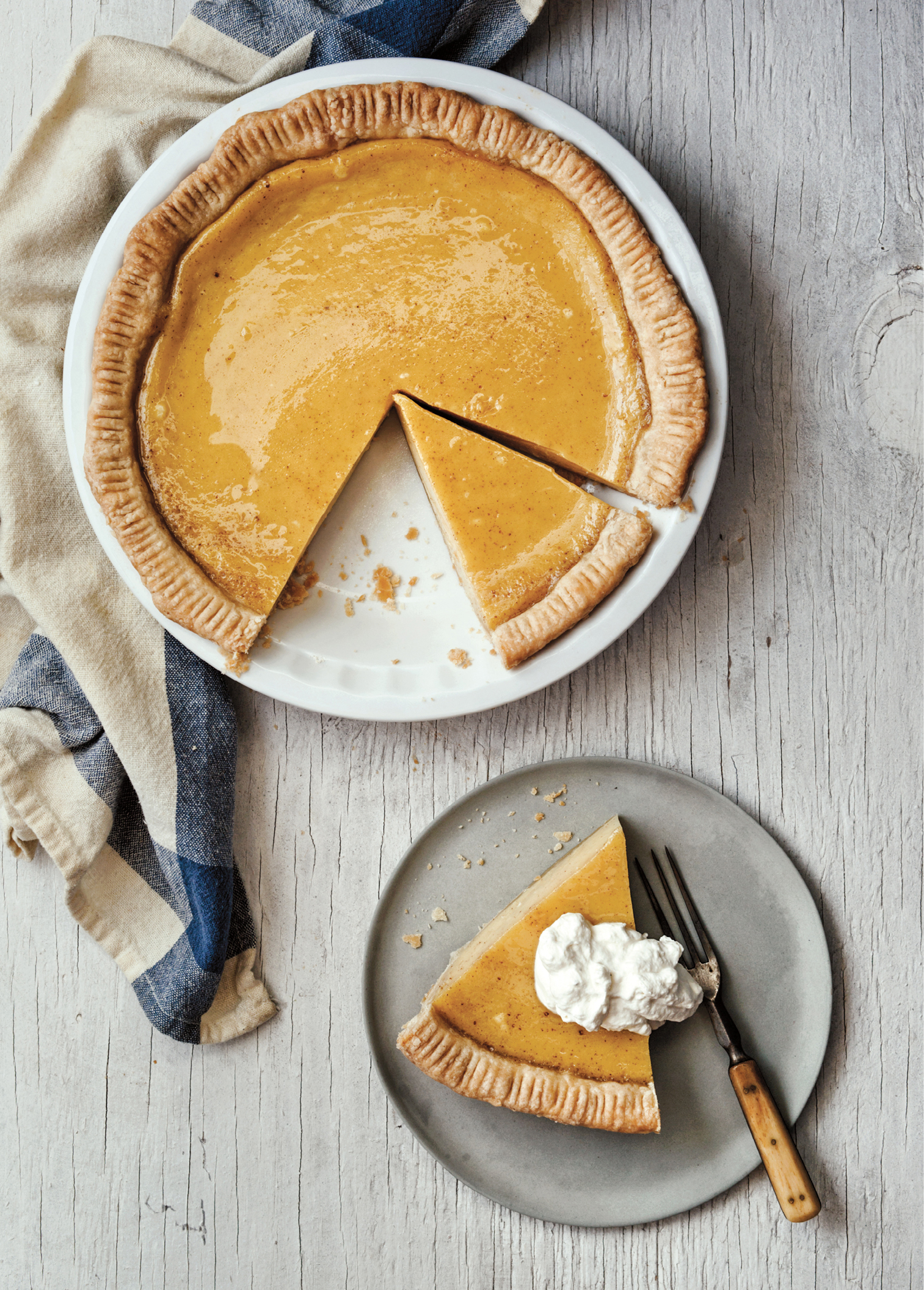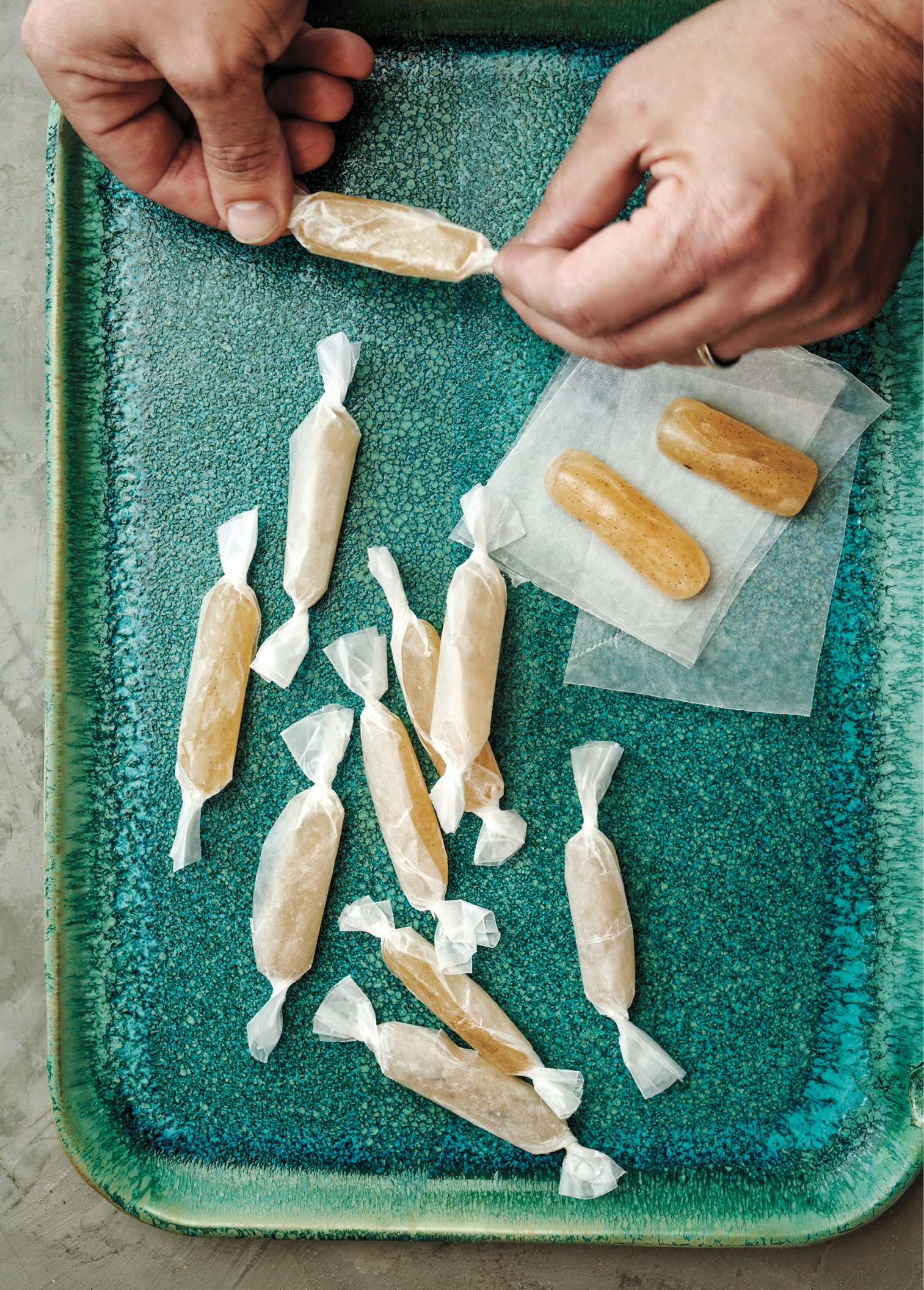
DESSERTS

We rarely think of vinegar in desserts, but why not? Tartness is welcome in treats like Key lime pie and lemon sorbet. With vinegar, we have one more ingredient that adds brightness besides citrus. Some recipes, like Vinegar Pie (this page), were invented out of necessity by pioneering families looking to flavor their food in the dreary depths of winter when store inventory was low and the possibility of fresh ingredients was still months away. Fruits like strawberries and bananas not only make great vinegars but also play really well with acetic flavors in dessert form. Think thick, goopy balsamic on sweet fresh strawberries—you don’t even need a recipe for that. Pour some berry vinegar (this page) and rum on ripe bananas and ignite the whole thing, or spray some apple cider vinegar on your crème brûlée. There are many ways to keep consuming all things vinegar even at the end of the meal.
VINEGAR PIE
MAKES 1 (9-INCH) PIE
When dried and stored fruit had worn out in winter and early settlers needed something to flavor their pies, they turned to vinegar. I first encountered this dessert in the second book of Laura Ingalls Wilder’s famous Little House series, Farmer Boy, which takes place during the 1870s in upstate New York, where apple cider vinegar would have been plentiful.
4 large eggs
1 cup sugar
¼ teaspoon ground cinnamon
⅛ teaspoon freshly grated nutmeg
1 tablespoon all-purpose flour
1 tablespoon good-quality maple syrup
⅓ cup homemade apple cider vinegar, or store-bought
1 Flaky Piecrust, unbaked
Whipped cream, for serving
- Preheat the oven to 350°F.
- In a nonreactive medium bowl, whisk the eggs with ¼ cup of the sugar, the cinnamon, and nutmeg until well blended. Set aside.
- In a medium nonreactive saucepan whisk together the flour, the remaining ¾ cup sugar, 1 cup of water, the maple syrup, and vinegar. Bring to a boil over medium-high heat, stirring to dissolve the sugar.
- When the sugar is dissolved, remove the saucepan from the heat and pour the liquid into the egg mixture. Mix well, then return the filling to the saucepan. Cook over low heat, stirring until the custard reaches 175°F; do not boil the custard.
- On a lightly floured surface, roll out the pie crust to a 13-inch round. Fit it into a 9-inch pie plate. Pour the mixture into the pie shell and bake for 30 to 40 minutes, or until the custard is set and the crust starts to brown.
- Remove the pie shell from the oven. Cool the pie completely before serving with whipped cream. Pie will keep covered in the refrigerator for up to 3 days.
TIP
This is a shallow one-shell pie, so double the recipe to make two, or save your second crust for another open custard-type pie. For a deep pie, multiply the recipe ingredients by one and a half.
FLAKY PIECRUST

MAKES 2 (9-INCH) CRUSTS
I learned to make piecrust from Lucinda Ray, a family friend, in the kitchen of her farmhouse on the island of Vinalhaven, Maine. Blueberry was the order of the day, but you can use this crust for anything. The keys to flaky piecrust are not to overwork it and to keep it cold. You can use other vinegars to pair with different fillings.
3 cups all-purpose flour
1 teaspoon kosher salt (see Tips)
1 teaspoon sugar (see Tips)
1 cup (2 sticks) cold unsalted butter, cut into ½-inch cubes
6 tablespoons cold lard or vegetable shortening, cut into ½-inch cubes
2 tablespoons vinegar (white distilled or any kind of homemade)
3 tablespoons ice water
- In a large nonreactive bowl, mix together the flour, salt, and sugar.
- Add the butter and lard and cut into the flour with a pastry blender, until the fat is pea-sized and evenly distributed.
- In a small nonreactive bowl, mix the vinegar and water. Sprinkle the liquid into the flour and shortening, and mix to combine just until the dough comes together.
- Divide the dough in halves, shape each into a ball, and press them into 2 flat rounds. If using immediately roll them out to ⅛-inch thick. Flat rounds of piecrust will keep wrapped in plastic in the freezer for up to 4 months.
TIPS
You can double the sugar if you’re making a sweet pie.
Double the salt if you’re using this for a savory pie.
BALSAMIC ICE CREAM

TOP: STRAWBERRY RHUBARB SHRUB, BOTTOM: BLUEBERRY SHRUB
SERVES 4
This dessert is a still-frozen ice cream, or semifreddo, as opposed to churned ice cream. While hand-churned ice cream will yield a smoother texture, this recipe works well and requires no special equipment. Serve it with fresh strawberries, raspberries, or blueberries.
2 large eggs, separated
½ cup confectioners’ sugar
1¼ cups whipping cream
2 tablespoons store-bought balsamic vinegar
½ teaspoon flaky sea salt, such as Maldon
- Beat the egg yolks, confectioners’ sugar, and ¼ cup of the whipping cream in a double boiler. Set the mixture over medium heat and cook until it starts to thicken, about 10 minutes. Chill the custard to room temperature or refrigerate until cool.
- In a small bowl, whip the remaining 1 cup whipping cream until thick. You can do this by hand with a whisk, an egg beater, or an electric mixer. Stir in the balsamic vinegar and salt. Fold the cooled custard into the whipped cream vinegar mixture.
- In another bowl—copper if you have it—whisk the egg whites until stiff but not dry. Copper helps the egg whites whip well without becoming dry and grainy.
- Fold the whipped cream and custard mixture into the egg whites. Pour the mixture into an 8 × 4-inch loaf pan or freeze-safe bowl, cover it, and freeze overnight before serving. This ice cream will last in the freezer well covered for up to 2 weeks.
VINEGAR CANDY

MAKES 60 CANDIES
We usually think of vinegar as a savory flavoring, but we should really consider it tart. In many candies, citric acid is used to brighten the sugar. Here we’ve replaced that with acetic acid, and you can make endless variations based on the type of vinegar used. Vary the vinegar for sherry or red wine candy.
2 tablespoons (¼ stick) unsalted butter, plus more for the pan
2 cups sugar
½ cup homemade apple cider vinegar or maple vinegar, or store-bought
½ teaspoon vanilla paste or extract
Flaky sea salt, such as Maldon
- In a medium nonreactive saucepan over medium heat, melt the butter and cook it until the foam subsides; don’t brown it.
- Add the sugar, vinegar, and vanilla, stirring to dissolve the sugar. Cook to a hard ball stage (260°F to 265°F on a candy thermometer for softer candy, 290°F to 300°F for brittle); do not stir. Watch the temperature carefully (see Tip).
- Turn out the mixture onto a Silpat mat, lightly buttered sheet pan, or into silicone candy molds to cool about 30 minutes; sprinkle with sea salt to taste.
- If you’re not using candy molds, roll the candy out into about a ½-inch rope, then cut or pull it into bite-sized pieces about 2 inches long (you can pull and knead it like taffy if you want). Wrap each in wax paper to store. The candy keeps at room temperature for up to 1 month.
TIP
Make sure that your candy thermometer is not sitting on the bottom of the pan so you can get an accurate reading of the candy’s temperature.
VINEGAR COMPOTE

Clabbered-Milk Blini
MAKES ABOUT 2 CUPS
This is a great catch-all recipe for summer, when berries and other fruit are at their height of flavor and availability. I always seem to have two or three kinds of fruit around, and when they start to get soft, I make this. You can, of course, start with fresher fruit, but I always seem to turn to this recipe to preserve overripe fruit. You can use just about any fruit for this and really any vinegar— use a balsamic or red wine vinegar with berries for a more intense flavor, and lighter vinegars like white wine vinegar or rice vinegar with apricots or pears for a more delicate taste. Serve over yogurt, ice cream, or clabbered-milk blini (see this page), or alongside lamb, goat, or roast beef. Don’t forget to season your compote: black pepper is a great addition for strawberries and stone fruit; feel free to experiment with other spices, too.
2 cups berries or bite-sized pieces of fruit (anything other than citrus)
⅔ cup sugar
½ cup store-bought balsamic vinegar or homemade red wine vinegar, white wine vinegar, or any fruit vinegar (this page), or store-bought
Pinch of salt
Freshly ground black pepper (optional)
- In a medium bowl, combine the fruit and sugar and let the fruit macerate for at least an hour at room temperature, or even covered overnight in the fridge.
- Mix the fruit and its juices with the vinegar in a medium nonreactive saucepan and simmer, uncovered, until the sauce thickens to the consistency of syrup or chocolate sauce; this could take as long as 20 minutes.
- Add salt and pepper to taste, if desired. Serve the compote warm or cold. Store the compote in a tightly sealed container in the refrigerator for up to 2 months, or, to make it shelf stable, pour it into a clean pint-sized mason jar, screw on a lid and ring, and follow the steps on this page for water-bath canning.
